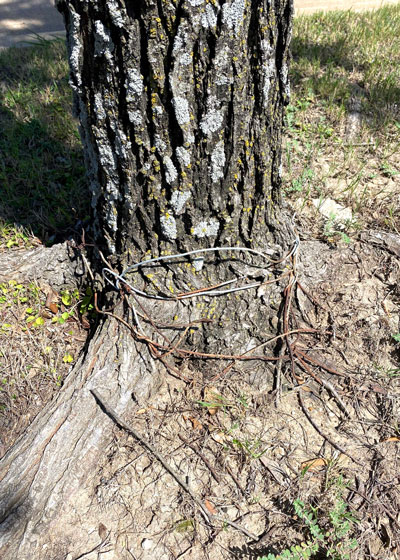What we do to our trees
This is a restaurant we visit once or twice a month, but we rarely park on this side of the lot.
We’ve been eating here since the place opened. That was almost 20 years ago, so that’s how long this cedar elm has been planted. That’s how long this wire has been in place encircling the trunk.

This was a balled-and-burlapped tree, meaning that it was dug out of a nursery or out of a field. That’s not uncommon for cedar elms. They were rarely grown in large nursery pots back in that era.
And to hold the soil ball in place as the tree was being moved and planted, it was wrapped in a wire fencing mesh.
That’s all well and good until the trunk (and the roots) grow large enough to be encircled by the wire of the mesh. In time those wires can gradually stop the free flow of nutrients and water through the plant.
Here’s what will happen to the trunk…
Think of the wood of the trunk in cross section, as if it had been cut off and you were looking down at the stump.
• The bark is on the outside. It is basically a dead tissue that protects everything on the inside. As the tree grows larger, the dead bark cells can’t expand, so they pop loose and slough off, falling to the ground. No harm done.
• Just inside the bark is the phloem. It’s a cylindrical tissue that carries the sugars that have been produced in the leaves down to the roots where they are stored and used to nourish the roots.
• Just inside the phloem is the cambium. It is also a cylindrical tissue that divides to produce more phloem to the outside and more xylem cells to the inside.
• Xylem makes up the greatest volume of a tree’s trunk. It’s the “lumber” that gets harvested, but to the tree, it functions as tiny straws that conduct water and nutrients up from the roots to the leaves where they are converted into sugars during photosynthesis.
Here’s where the rub comes in…
As a tree grows larger and adds more xylem as its trunk increases in diameter, if there is a wire, nylon twine, plastic zip tie or any other unyielding binding around the trunk, the tree will literally grow around the binding until it cuts through the bark, phloem and then the cambium.
That’s a process known as “girdling” of a tree trunk, and it also happens when we use a line trimmer and let it knock the bark off the trunk near the ground. Dog chains will do the same thing. You never want to let anything cut the bark all the way around the trunk for fear that you’ll cut off that necessary supply line down to the roots.
In the case of the tree in my photo, there still is time to save this particular tree. I’ll point the problem out to the manager of the restaurant. Hopefully she’ll be able to contact the property owner who will contact the landscape company who will send word to the foreman…. Or, if all that doesn’t work, I may just walk over to it with a pair of shears and clip it myself.
